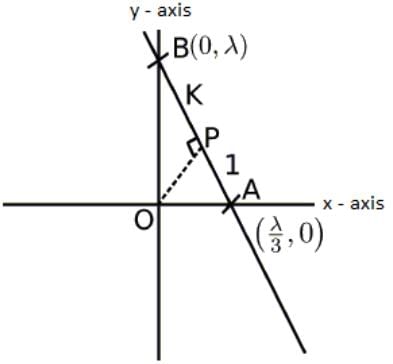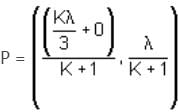JEE Exam > JEE Questions > The foot of the perpendicular drawn from the ...
Start Learning for Free
The foot of the perpendicular drawn from the origin on the line 3x + y = λ (λ ≠ 0) is P. If the line meets x-axis at A and y-axis at B, then the ratio BP : PA is:
- a)1 : 9
- b)1 : 3
- c)9 : 1
- d)3 : 1
Correct answer is option 'C'. Can you explain this answer?
Verified Answer
The foot of the perpendicular drawn from the origin on the line 3x + y...

Let BP : PA = K : 1

Since slope mOP x slope mAB = -1;

So, PB : PA = K : 1 = 9 : 1
Most Upvoted Answer
The foot of the perpendicular drawn from the origin on the line 3x + y...
Given:
The equation of the line is 3x + y = λ (λ ≠ 0)
P is the foot of the perpendicular drawn from the origin to the line
The line intersects the x-axis at A and the y-axis at B
To Find:
The ratio BP : PA
Solution:
Finding the Coordinates of A, B, and P:
- To find the coordinates of A, set y = 0 in the equation of the line: 3x = λ
- So, x = λ/3, which gives the coordinates of A as (λ/3, 0)
- To find the coordinates of B, set x = 0 in the equation of the line: y = λ
- So, the coordinates of B are (0, λ)
- The equation of the line perpendicular to 3x + y = λ passing through the origin is y = -3x
- Solving the equations 3x + y = λ and y = -3x, we get the coordinates of P as (λ/10, -3λ/10)
Calculating the Ratio BP : PA:
- Using the distance formula, calculate the lengths BP and PA
- BP = √((0 - λ)^2 + (λ + 3λ/10)^2) = √(λ^2 + (13λ/10)^2) = √(λ^2 + 169λ^2/100) = √(269λ^2/100) = λ√269/10
- PA = √((λ/3 - λ/10)^2 + (0 + 3λ/10)^2) = √((7λ/30)^2 + (3λ/10)^2) = √(49λ^2/900 + 9λ^2/100) = √(49λ^2/900 + 81λ^2/900) = √(130λ^2/900) = λ√13/30
- Therefore, the ratio BP : PA = (λ√269/10) : (λ√13/30) = √269/10 : √13/30 = 3√269 : √13
- Simplifying further, we get the ratio as 9 : 1
Therefore, the ratio BP : PA is 9 : 1.
The equation of the line is 3x + y = λ (λ ≠ 0)
P is the foot of the perpendicular drawn from the origin to the line
The line intersects the x-axis at A and the y-axis at B
To Find:
The ratio BP : PA
Solution:
Finding the Coordinates of A, B, and P:
- To find the coordinates of A, set y = 0 in the equation of the line: 3x = λ
- So, x = λ/3, which gives the coordinates of A as (λ/3, 0)
- To find the coordinates of B, set x = 0 in the equation of the line: y = λ
- So, the coordinates of B are (0, λ)
- The equation of the line perpendicular to 3x + y = λ passing through the origin is y = -3x
- Solving the equations 3x + y = λ and y = -3x, we get the coordinates of P as (λ/10, -3λ/10)
Calculating the Ratio BP : PA:
- Using the distance formula, calculate the lengths BP and PA
- BP = √((0 - λ)^2 + (λ + 3λ/10)^2) = √(λ^2 + (13λ/10)^2) = √(λ^2 + 169λ^2/100) = √(269λ^2/100) = λ√269/10
- PA = √((λ/3 - λ/10)^2 + (0 + 3λ/10)^2) = √((7λ/30)^2 + (3λ/10)^2) = √(49λ^2/900 + 9λ^2/100) = √(49λ^2/900 + 81λ^2/900) = √(130λ^2/900) = λ√13/30
- Therefore, the ratio BP : PA = (λ√269/10) : (λ√13/30) = √269/10 : √13/30 = 3√269 : √13
- Simplifying further, we get the ratio as 9 : 1
Therefore, the ratio BP : PA is 9 : 1.

|
Explore Courses for JEE exam
|

|
Similar JEE Doubts
The foot of the perpendicular drawn from the origin on the line 3x + y =λ(λ≠0)is P. If the line meets x-axis at A and y-axis at B, then the ratio BP : PA is:a)1 : 9b)1 : 3c)9 : 1d)3 : 1Correct answer is option 'C'. Can you explain this answer?
Question Description
The foot of the perpendicular drawn from the origin on the line 3x + y =λ(λ≠0)is P. If the line meets x-axis at A and y-axis at B, then the ratio BP : PA is:a)1 : 9b)1 : 3c)9 : 1d)3 : 1Correct answer is option 'C'. Can you explain this answer? for JEE 2025 is part of JEE preparation. The Question and answers have been prepared according to the JEE exam syllabus. Information about The foot of the perpendicular drawn from the origin on the line 3x + y =λ(λ≠0)is P. If the line meets x-axis at A and y-axis at B, then the ratio BP : PA is:a)1 : 9b)1 : 3c)9 : 1d)3 : 1Correct answer is option 'C'. Can you explain this answer? covers all topics & solutions for JEE 2025 Exam. Find important definitions, questions, meanings, examples, exercises and tests below for The foot of the perpendicular drawn from the origin on the line 3x + y =λ(λ≠0)is P. If the line meets x-axis at A and y-axis at B, then the ratio BP : PA is:a)1 : 9b)1 : 3c)9 : 1d)3 : 1Correct answer is option 'C'. Can you explain this answer?.
The foot of the perpendicular drawn from the origin on the line 3x + y =λ(λ≠0)is P. If the line meets x-axis at A and y-axis at B, then the ratio BP : PA is:a)1 : 9b)1 : 3c)9 : 1d)3 : 1Correct answer is option 'C'. Can you explain this answer? for JEE 2025 is part of JEE preparation. The Question and answers have been prepared according to the JEE exam syllabus. Information about The foot of the perpendicular drawn from the origin on the line 3x + y =λ(λ≠0)is P. If the line meets x-axis at A and y-axis at B, then the ratio BP : PA is:a)1 : 9b)1 : 3c)9 : 1d)3 : 1Correct answer is option 'C'. Can you explain this answer? covers all topics & solutions for JEE 2025 Exam. Find important definitions, questions, meanings, examples, exercises and tests below for The foot of the perpendicular drawn from the origin on the line 3x + y =λ(λ≠0)is P. If the line meets x-axis at A and y-axis at B, then the ratio BP : PA is:a)1 : 9b)1 : 3c)9 : 1d)3 : 1Correct answer is option 'C'. Can you explain this answer?.
Solutions for The foot of the perpendicular drawn from the origin on the line 3x + y =λ(λ≠0)is P. If the line meets x-axis at A and y-axis at B, then the ratio BP : PA is:a)1 : 9b)1 : 3c)9 : 1d)3 : 1Correct answer is option 'C'. Can you explain this answer? in English & in Hindi are available as part of our courses for JEE.
Download more important topics, notes, lectures and mock test series for JEE Exam by signing up for free.
Here you can find the meaning of The foot of the perpendicular drawn from the origin on the line 3x + y =λ(λ≠0)is P. If the line meets x-axis at A and y-axis at B, then the ratio BP : PA is:a)1 : 9b)1 : 3c)9 : 1d)3 : 1Correct answer is option 'C'. Can you explain this answer? defined & explained in the simplest way possible. Besides giving the explanation of
The foot of the perpendicular drawn from the origin on the line 3x + y =λ(λ≠0)is P. If the line meets x-axis at A and y-axis at B, then the ratio BP : PA is:a)1 : 9b)1 : 3c)9 : 1d)3 : 1Correct answer is option 'C'. Can you explain this answer?, a detailed solution for The foot of the perpendicular drawn from the origin on the line 3x + y =λ(λ≠0)is P. If the line meets x-axis at A and y-axis at B, then the ratio BP : PA is:a)1 : 9b)1 : 3c)9 : 1d)3 : 1Correct answer is option 'C'. Can you explain this answer? has been provided alongside types of The foot of the perpendicular drawn from the origin on the line 3x + y =λ(λ≠0)is P. If the line meets x-axis at A and y-axis at B, then the ratio BP : PA is:a)1 : 9b)1 : 3c)9 : 1d)3 : 1Correct answer is option 'C'. Can you explain this answer? theory, EduRev gives you an
ample number of questions to practice The foot of the perpendicular drawn from the origin on the line 3x + y =λ(λ≠0)is P. If the line meets x-axis at A and y-axis at B, then the ratio BP : PA is:a)1 : 9b)1 : 3c)9 : 1d)3 : 1Correct answer is option 'C'. Can you explain this answer? tests, examples and also practice JEE tests.

|
Explore Courses for JEE exam
|

|
Signup for Free!
Signup to see your scores go up within 7 days! Learn & Practice with 1000+ FREE Notes, Videos & Tests.


























